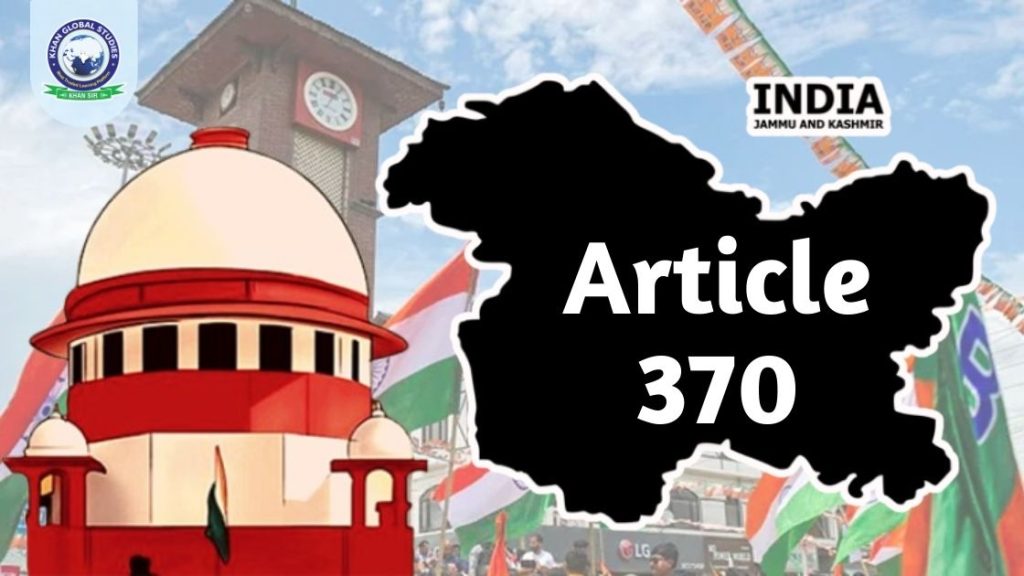Article 370 of the Indian Constitution was a temporary provision that provided special status to the state of Jammu and Kashmir (J&K). Enacted in 1949, it was intended to facilitate the integration of the state into India while addressing its unique historical and political circumstances. However, it became the subject of much debate and controversy, culminating in its repeal by the Government of India in 2019.
What is Article 370?
- Article 370, included in the Indian Constitution on 17 October 1949, exempted Jammu and Kashmir from the Indian Constitution.
- The Article 370 gave some special rights to Kashmir. Article 370 is a constitutional provision that gives special status to Jammu and Kashmir.
- Under this, even in case of unrest, an emergency could not be imposed without the state government’s permission. However, on August 5, 2019, approval was given to remove Section 370 and 35A from Kashmir.
- Under Section (1) of Article 370 of the Indian Constitution through the Constitution (77th Amendment) Act, 1995 and the Constitution (103rd Amendment) Act, 2019 after the President issued the Constitution (Applicable to Jammu and Kashmir) Amendment Order, 2019 The amendment was made. The relevant provisions of this Act will come into force.
What is the History of Article 370?
The history of Article 370 is quite old. The process of implementing Article 370 of the Indian Constitution began in the year 1950 and thereafter several negotiations took place between the central and state leadership. In this, apart from the Instrument of Accession, it was agreed to implement many subjects in the state of Jammu and Kashmir.
The Constitution of Jammu and Kashmir was adopted on 17 November 1956 and came into force on 26 January 1957. On 27 November 1963, on the floor of the Lok Sabha, Pandit Nehru said that Article 370 had been destroyed. A year later, the then Home Minister Gulzari Lal Nanda again said on the floor of the Lok Sabha on 4 December 1964, that Article 370 is a tunnel to take the Constitution of India to Jammu and Kashmir.
What were the provisions of Article 370?
Along with knowing Article 370, you should also know the provisions of Section 370 which are as follows:
- The Indian Parliament will require the approval of the Government of Jammu and Kashmir to make any law in Jammu and Kashmir, except in defence, foreign and communications matters.
- The law governing citizenship, property and fundamental rights of residents of Jammu and Kashmir differed from that of people living in other Indian states.
- Under this, citizens of other states of India could not buy property in Jammu and Kashmir.
- Under this, the Center did not have the power to declare a financial emergency there.
- Due to this section, laws like RTI and CAG were not applicable in Kashmir.
- The citizens of Jammu and Kashmir had dual citizenship.
- Jammu and Kashmir had a separate national flag.
- The tenure of the Legislative Assembly of Jammu and Kashmir was 6 years and the tenure of the Legislative Assembly of other states of India was 5 years.
- The orders of the Supreme Court of India were not valid in Jammu and Kashmir.
- If a woman from Jammu and Kashmir marries a man from any other state of India, her citizenship is lost and if she marries a man from Pakistan, she also gets the citizenship of Jammu and Kashmir.
When was Article 370 abrogated?
Article 370 was removed on 5 August 2019 and for this, the Central Government introduced a bill in the Parliament, after which it was approved, and Article 370 was repealed. Let us tell you that according to the Indian Constitution, Section 370 was a temporary provision and there was a provision to remove it by making a law by the Parliament after the consent of the State Assembly. According to media reports, the logic behind the removal of it was the development of the state and connecting the people there with the mainstream.
What will be the impact on Jammu and Kashmir due to the removal of Article 370?
After the constitutional transformation and reorganization of the erstwhile state of Jammu and Kashmir, the Union Territories of Jammu Kashmir and Ladakh have been fully integrated into the mainstream of the nation. With the conduct of elections to Panchayati Raj institutions like Panches and Sarpanches, Block Development Councils and District Development Councils, a 3-tier system of grassroots democracy has now been established in Jammu and Kashmir.
Changes made by Jammu and Kashmir Reorganization Act-2019
- The Presidential Order of 1954 has been replaced by the Constitution (Applicable to Jammu and Kashmir Order) 2019.
- Due to this, the state of Jammu and Kashmir has been divided into two new union territories, Jammu and Kashmir and Ladakh.
- This is the first time in the history of India that a state has been converted back into a Union Territory under the provisions of the Jammu and Kashmir Reorganization Bill 2019.
Currently, the state of Jammu and Kashmir has 6 Lok Sabha seats, which will be divided among the Union Territories of Jammu, Kashmir and Ladakh in the ratio of 5:1. Like the Union Territories of Delhi and Puducherry, the Union Territory of Jammu and Kashmir will also have a Legislative Assembly. However, there will be no assembly in the Union Territory of Ladakh. In Kashmir and Ladakh, the Lieutenant Governor will be appointed in place of the Governor.
Why is Article 370 in discussion at this time?
After the removal of Article 370, many petitions were filed in the Supreme Court challenging it. At present, i.e. in December 2023, the Supreme Court has started hearing the petitions on which the verdict has been given on 11 December 2023. The Supreme Court has said that the decision to remove it is not a wrong decision and the Central Government can do it.
Article 35A
The Article 35A originates from Article 370. Article 35A was first introduced in 1954 by Presidential order. The Constituent Assembly of Jammu and Kashmir had also recommended Article 35A. With the enactment of the Constitution (Applicable to Jammu and Kashmir Order), 2019, on 5 August 2019, Articles 370 and 35A were repealed from the Indian Constitution.
FAQs
Question: When was Article 370 implemented?
Answer: Article 370 was included in the Constitution of India on 17 October 1949.
Question: What is the decision of the Supreme Court on Article 370?
Answer: The Supreme Court has accepted the removal of Section 370 in Jammu and Kashmir as valid on 11 December 2023.
Question: Has Article 370 been removed?
Answer: On August 5, 2019, approval was given to remove Section 370 and 35A from Kashmir.
Question: When was Article 370 removed?
Answer: Approval to remove Section 370 was given on 5 August 2019.




